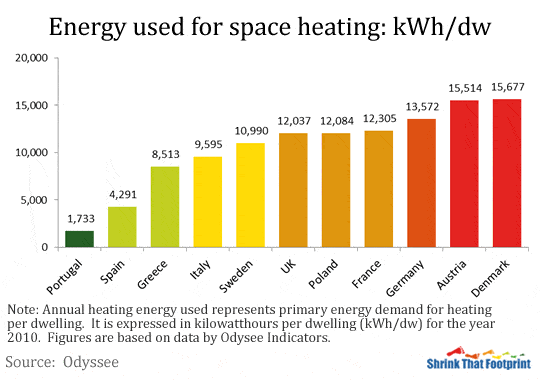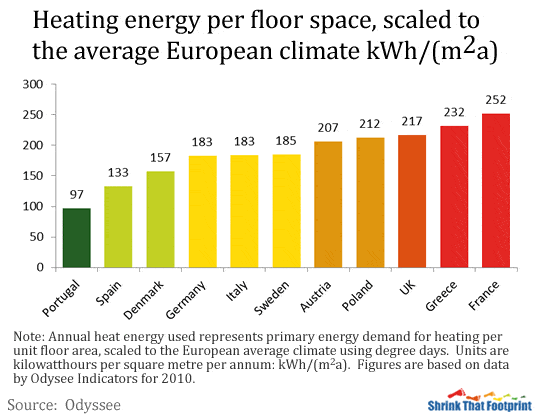How Much Energy You Use To Heat Your Home?
Is it about 20,000 kWh a year, or more like 10,000 kWh? Do you know what it is per square meter?
Although many people have a rough idea how much they spend on fuel bills, few people actually know how much energy they use specifically for heating.
That’s a shame, because it is the first question to ask yourself if you want to reduce your heating footprint, or your heating bills for that matter. The two big ways to affect your energy use is to 1) modulate the usage, 2) improve the efficiency of a home, which can happen through both interior and exterior architectural changes.
Measuring Your Heating Energy Use
A ‘typical’ home in a mild climate uses between 5,000 kWh and 30,000 kWh of energy a year for its heating. So how much does your home use? It’s reasonable that 5,000 kWh corresponds to warmer regions and 30,000 kWh to cold regions. The former requires less and the latter requires more heating per month. The average home we know uses about 10,000 kWh of electricity, and on top of that, heat energy will add more.
Whether you use natural gas, fuel oil, electricity or something else to heat your home, you should be able to measure your heating energy use. The two best places to start are your energy meters and energy bills. If you use just one fuel for heating, and nothing else, then the annual usage for that fuel is your number. So that should be quite easy to find.
If you use electricity or gas for your heating, then the chances are you also use it for other things like cooking, water heating, lighting and appliances. To account for this you can take advantage of the fact that unlike most other energy needs, heating is seasonal.
Let’s say a home only uses electricity for its energy needs, and over a year uses 16,000 kWh for everything including lighting, appliances, cooking, water heating and heating. If we know that over 6 months when the house isn’t heated it uses 3,000 kWh for everything except heating, we can assume roughly the same is used over the winter months for these same things. So over a year non-heating demand accounts for 6,000 kWh, and the remaining 10,000 kWh is used for heating.
Depending on where you live, and the fuel you use, you will work energy use in any number of different units. To keep things simple we are only using kilowatt-hours (kWh) in this post. To convert other measures of energy to kWh you can use the following conversion factors. In each case you simply multiply by a constant to convert to kWh.
Conversion factors
BTU x 0.000293 = 1 kWh
Therms x 29.3 = 1 kWh
Tons of oil equivalent (TOE) x 11,630 = 1 kWh
Gigajoule (GJ) x 278 = 1 kWh
Kilocalorie x 0.00116 = 1 kWh
If you have isolated the energy you use for heating, and converted it to kWh, you are in a position to compare your energy use with other houses and benchmarks. This energy demand depends on a number of things including: the size of the home, the local climate, the comfort level maintained, the heating system and the construction of the home.
Comparing Your Home’s Heating Energy Use
Let’s say you have worked out your own heating energy use, and it turns out to be 10,000 kWh. How does this compare?
The following chart shows the heating energy use in a number of European countries in 2010. These numbers represent heating energy use per dwelling per year. Just like you can calculate for your own home.

Based on this data 10,000 kWh of heating energy would mean your home uses a little more than the average Italian home. If you lived in a country with cold winters like Denmark, then 10,000 kWh might be a quite low figure, but in a warm place like Spain it would be relatively high.
Even when you account for differences in climate, average figures like this don’t allow for variation in the home size.
Accounting For Differences In Home Size
To get around the issue of varying house size it is standard for heating demand to be compared per unit floor area. If in our example that uses 10,000 kWh of energy, and the floor area of the home is 100 m2 then it would be using 100 kWh/(m2a), where the ‘a’ denotes per annum (year).
We can do the same thing with our average European examples based on typical dwelling size for each country.

Once we account for floor size we get a slightly different picture. Now our 100 kWh/(m2a) looks the same as Greece.
Estimating your heating energy use per unit floor area is really useful, because it lets you compare your usage to various benchmarks. Perhaps the most famous one of these is the Passive House (Passivhaus) standard which limits heating energy use to just 15 kWh/(m2a).
If you have worked out your energy use in terms of floor area you can really start to understand how much energy you are using for heating. This is the starting point for getting to grips with strategies to reduce your heating footprint.
Heating kWh Per Square Meter
To wring a bit more detail out of the above calculation, we also note here the standard estimate for the amount of heating needed per unit area is 20 BTU per square foot. Remember that 1 kWh is 3412 BTU and a square foot is 0.0929 m2. Therefore another way to express this figure is 0.000545 kWh per m2.
Adjusting For Difference In Climate
If you want to get really technical, you can also compare by accounting for your local climate. This is done using ‘degree days’ to allow for the amount of heating required to maintain a certain temperature in a given climate.
This process is a bit technical, so we aren’t going to deal with it properly in this post. We can however show our European example again, but his time with each country’s heating demand scaled to the average European climate using degree days.
It is worth stressing that these numbers are not actual usage numbers. They are instead a comparison of heating energy use per square metre, with all usages scaled to the average European climate.

Now that we have accounted for variations in average climate, the countries are ranked quite differently. Places like Denmark and Germany actually use less heating energy than most, once you have accounted for their colder climates and the differences in dwelling size.
Putting It Together
The first step towards reducing your heating footprint is understanding how much heating energy you use. Using this number you can calculate your current heating footprint, compare the potential of new heating systems, assess your use of heating controls and analyse how to improve your home’s insulation.
Lindsay Wilson
I founded Shrink That Footprint in November 2012, after a long period of research. For many years I have calculated, studied and worked with carbon footprints, and Shrink That Footprint is that interest come to life.
I have an Economics degree from UCL, have previously worked as an energy efficiency analyst at BNEF and continue to work as a strategy consultant at Maneas. I have consulted to numerous clients in energy and finance, as well as the World Economic Forum.
When I’m not crunching carbon footprints you’ll often find me helping my two year old son tend to the tomatoes, salad and peppers growing in our upcycled greenhouse.
